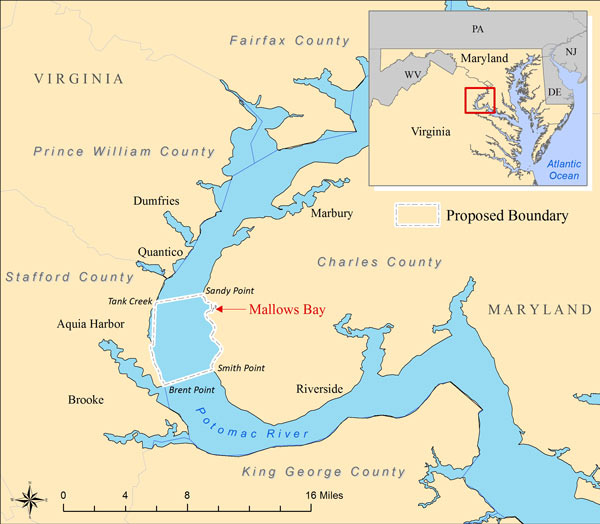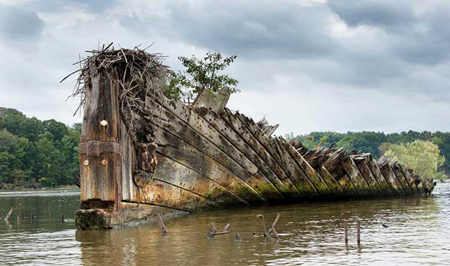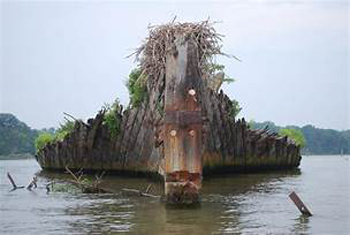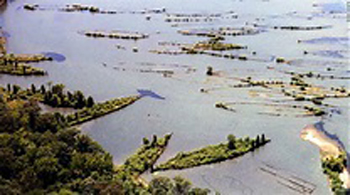Mallows Bay: Graveyard for Government Boo-Boo
History unveils a plethora of government boondoggles in decision making and expenditures. In most instances, the facts remain in place and the evidence fades away. Such is not the case in Mallows Bay, Charles County, Maryland, where a decision made during WWI leaves to this day a vast graveyard of decomposing vessels that never saw a bit of service. Hailed as the “largest maritime graveyard in the Western Hemisphere,” it goes down in history as one of the government’s biggest blunders.

Mallows Bay, Potomac River, Charles County Maryland (Credit: NOAA)
It all began with good intentions, the United States simply trying to rescue its Allies and hasten the end of hostilities. It was called the Great War, a global conflict begun in Europe on July 28, 1914 and lasting until November 11, 1918. We joined Russia, France, England and other Allies on April 6, 1917, to battle Germany, Austria, Hungary and others that misjudged the power of a united front.

One of over 100 wooden ships abandoned in Mallows Bay (Credit: Don Shomette)

Osprey’s nest atop wreck of the Benzonia (Credit: Don Shomette)
In 1993, marine archaeologist Donald Shomette of Dunkirk, Maryland, headed the first effort to evaluate the fleet. He identified 88 of the original 154 wooden steamships purported to be there. He found other wrecks as well including a ferryboat, 12 barges, a Revolutionary War longboat, log canoes, schooners, a menhaden boat and several workboats. Further details of these and other interesting facts can be found in The Ghost Fleet of Mallows Bay by Donald Shomette. Charles County officials, fearing the thought of their wetlands being cast as a dumping ground, turned the whole image around. In conjunction with the Federal Bureau of Land Management and the Maryland Department of Natural Resources, the county purchased 5,000 acres and 10 miles of shoreline to establish one of the finest reserves in the Mid-Atlantic region.

The Ghost Fleet of Mallows Bay (Credit: NOAA)
Officials of the Free State took a government gaffe from yesteryear and turned it into a present-day project of pride and purpose. The irony is this time the government’s help has a positive spin to it which benefits countless outdoor enthusiasts.
Author: Ellsworth Boyd
Ellsworth Boyd, Professor Emeritus, College of Education, Towson University, Towson, Maryland, pursues an avocation of diving and writing. He has published articles and photo’s in every major dive magazine in the US., Canada, and half a dozen foreign countries. An authority on shipwrecks, Ellsworth has received thousands of letters and e-mails from divers throughout the world who responded to his Wreck Facts column in Sport Diver Magazine. When he’s not writing, or diving, Ellsworth appears as a featured speaker at maritime symposiums in Los Angeles, Houston, Chicago, Ft. Lauderdale, New York and Philadelphia. “Romance & Mystery: Sunken Treasures of the Lost Galleons,” is one of his most popular talks. A pioneer in the sport, Ellsworth was inducted into the International Legends of Diving in 2013.
8 Comments
Submit a Comment
All Rights Reserved © | National Underwater and Marine Agency
All Rights Reserved © | National Underwater and Marine Agency
Web Design by Floyd Dog Design
Web Design by Floyd Dog Design

I enjoyed your Mallows Bay article. It’s quite informative. I had never heard of the bay, but now I can’t wait to visit it and kayak around the old wrecks.
Oh good! I was hoping that viewers would read about Mallows Bay and then make plans for a visit. Good luck Have a great time!
I liked reading about Mallows Bay. I didn’t know about it. My goodness, the government surely goofed in building all those ships. Your story aroused my interest to go there. I don’t live too far from Charles County. Would there be kayak rentals?
I’m pleased you liked my article. Go to: http://www.charlescountyparks.com or call (301)932-3470 (Mon-Fri, 4 to 2:30 p.m.)for information. The Charles County Dept. of Recreation & Parks sponsors kayak tours on Sundays with a guide. They call it Kayak Tours of Mallows Bay Park.
Please E. Boyd ….. First World War or the Great War, was a global war originating in Europe that lasted from 28 July 1914 to 11 November 1918.
there is a memorial “on the eleventh hour on the elevenths day on the Elevenths months, finally the guns fall silent and the great war was over.”
Can you change this date in your article , Please?
I like your writing but this is too much.
Maro: THANK YOU VERY MUCH!I don’t know where I got those dates! I must have been smoking some thing at the time of that writing! I am a stickler for the correct times, places, dates, etc., so I appreciate your correction. And thank you for your kind words about my articles. Cheers, Ellsworth (The webmaster will make the correction after the holiday)
It is a fascinating trip into history and the re-establishment of mini-eco systems that developed around the ships. At low tide the hulls of some ship are very close to the surface. You have to pay attention. Threre is a kayak launch.
Larry: Many thanks. That’s an interesting point about the eco systems. My wife and I plan to visit Mallows Bay in the spring. All information on it is welcome.